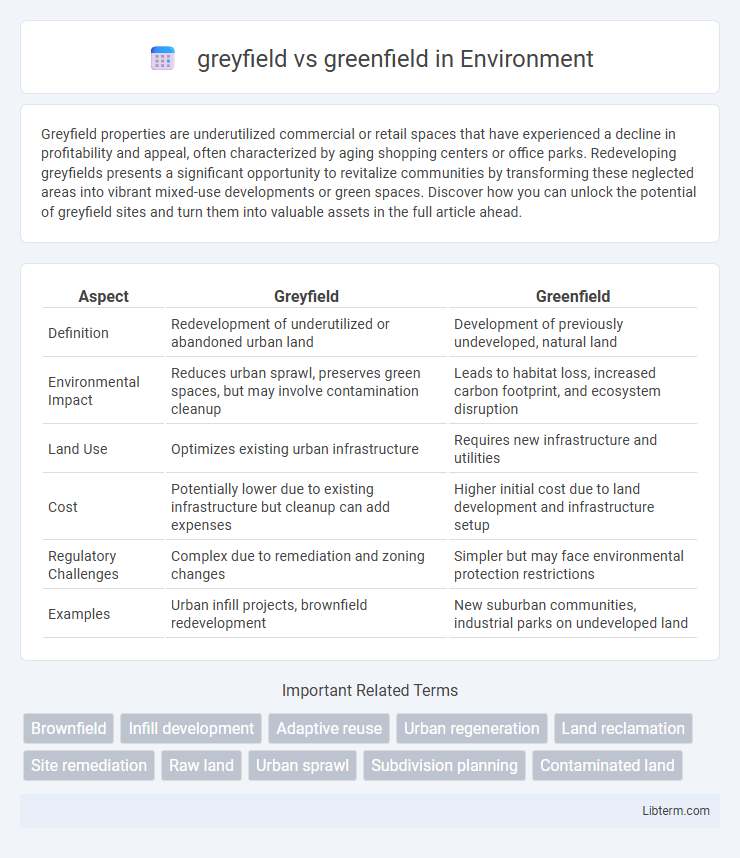Greyfield properties are underutilized commercial or retail spaces that have experienced a decline in profitability and appeal, often characterized by aging shopping centers or office parks. Redeveloping greyfields presents a significant opportunity to revitalize communities by transforming these neglected areas into vibrant mixed-use developments or green spaces. Discover how you can unlock the potential of greyfield sites and turn them into valuable assets in the full article ahead.
Table of Comparison
| Aspect | Greyfield | Greenfield |
|---|---|---|
| Definition | Redevelopment of underutilized or abandoned urban land | Development of previously undeveloped, natural land |
| Environmental Impact | Reduces urban sprawl, preserves green spaces, but may involve contamination cleanup | Leads to habitat loss, increased carbon footprint, and ecosystem disruption |
| Land Use | Optimizes existing urban infrastructure | Requires new infrastructure and utilities |
| Cost | Potentially lower due to existing infrastructure but cleanup can add expenses | Higher initial cost due to land development and infrastructure setup |
| Regulatory Challenges | Complex due to remediation and zoning changes | Simpler but may face environmental protection restrictions |
| Examples | Urban infill projects, brownfield redevelopment | New suburban communities, industrial parks on undeveloped land |
Introduction to Greyfield and Greenfield Projects
Greyfield projects involve the redevelopment of underutilized or obsolete commercial properties, often in urban areas, presenting opportunities to revitalize existing infrastructure and reduce urban sprawl. Greenfield projects refer to new developments on previously undeveloped land, offering greater design flexibility but often requiring more extensive environmental assessments and infrastructure investments. Understanding the distinctions between these project types is essential for urban planners and developers aiming to balance sustainability, cost, and community impact.
Defining Greyfield Sites
Greyfield sites refer to previously developed properties, such as underutilized or abandoned commercial real estate like outdated shopping malls, office parks, or industrial facilities. These areas face challenges like obsolete infrastructure, environmental concerns, and decreased market demand but offer opportunities for urban redevelopment, adaptive reuse, and sustainable infill projects. Unlike greenfield sites, which are undeveloped land open for new construction, greyfield redevelopment leverages existing locations to revitalize communities and reduce urban sprawl.
Understanding Greenfield Developments
Greenfield developments refer to the construction of new buildings or infrastructure on previously undeveloped land, often in rural or suburban areas with no existing structures. These projects offer developers complete design freedom and the ability to implement modern technologies and sustainable practices from the ground up. Greenfield investments typically involve higher initial costs due to land acquisition but provide long-term benefits such as optimized land use and fewer regulatory constraints compared to greyfield redevelopment.
Key Differences between Greyfield and Greenfield
Greyfield projects involve the redevelopment or reuse of previously developed land with underused or obsolete structures, often requiring significant demolition and infrastructure updates. Greenfield projects consist of developing on untouched, undeveloped land, allowing for more flexibility in design and typically fewer regulatory challenges. The key differences lie in the site conditions, costs, environmental impact, and redevelopment complexity.
Environmental Impact: Greyfield vs Greenfield
Greyfield developments typically repurpose underutilized or abandoned urban land, reducing the environmental impact by minimizing land disturbance and preserving green spaces. Greenfield projects often require clearing undeveloped natural areas, leading to habitat loss, increased carbon emissions, and greater soil erosion. Choosing greyfield sites supports sustainable urban growth and lowers ecological footprints compared to greenfield expansion.
Economic Considerations in Site Selection
Greyfield site selection often appeals to developers due to existing infrastructure and reduced initial construction costs, leveraging underutilized urban areas with potential for economic revitalization. Greenfield projects usually demand higher upfront investment for land acquisition and infrastructure development but offer greater flexibility in design and long-term planning. Economic considerations weigh factors such as redevelopment incentives, market demand, and cost-benefit analysis of site preparation and environmental remediation.
Regulatory and Zoning Challenges
Greyfield developments face complex regulatory and zoning challenges due to the necessity of repurposing existing properties, often requiring compliance with outdated codes and environmental remediation standards. Greenfield projects generally benefit from clearer zoning designations but must navigate environmental impact assessments and infrastructure development permits. Understanding local land-use policies, permitting timelines, and community opposition is critical for mitigating delays in both greyfield and greenfield project approvals.
Urban Revitalization with Greyfield Redevelopment
Greyfield redevelopment in urban revitalization targets underutilized commercial properties with outdated infrastructure, transforming them into vibrant, mixed-use spaces that stimulate economic growth and community engagement. Unlike greenfield development, which involves building on undeveloped land, greyfield projects prioritize sustainable reuse of existing sites, reducing urban sprawl and preserving natural resources. Strategic greyfield revitalization improves property values, attracts investment, and enhances urban density while addressing blight and infrastructure challenges.
Sustainability and Future Trends
Greyfield developments reuse existing underutilized urban sites, reducing the environmental impact of new construction by minimizing land consumption and preserving natural habitats. Greenfield projects involve building on undeveloped land, often leading to habitat disruption and increased carbon footprints but allowing for the integration of cutting-edge sustainable technologies from the ground up. Future trends emphasize hybrid models combining greyfield revitalization with smart, eco-friendly designs to balance urban regeneration and green innovation.
Choosing the Right Approach: Factors to Consider
Choosing between greyfield and greenfield development depends on project goals, budget, and site conditions. Greyfield projects leverage existing infrastructure and urban locations, often reducing costs and timelines, while greenfield developments offer complete design freedom on undeveloped land but may require extensive permitting and infrastructure investment. Environmental impact, community integration, and long-term sustainability goals also play critical roles in determining the optimal approach.
greyfield Infographic

 libterm.com
libterm.com